Recent Developments in Solar Energy-Harvesting Technologies for Building Integration and Distributed Energy Generation
Abstract
:1. Introduction
2. Main Technologies for Integrating Energy Harvesting Surfaces into Buildings
3. Principal Results in Semi-Transparent PV Module Development, New Materials for Solar Concentrators, and Current Trends in Transparent Energy Harvesters
3.1. Recent Developments in Semitransparent Non-Concentrating BIPV Technologies
3.2. Progress in Semitransparent Concentrator-Type Solar Window Technologies
3.3. Examples of Existing and Emergent High-Transparency PV Window Technologies and Their Applications
4. Conclusions and Outlook
Supplementary Materials
Author Contributions
Funding
Conflicts of Interest
References
- Capuano, L. International Energy Outlook 2018 (IEO2018); US Energy Information Administration: Washington, DC, USA, 2018. [Google Scholar]
- Chu, S.; Majumdar, A. Opportunities and challenges for a sustainable energy future. Nature 2012, 488, 294–303. [Google Scholar] [CrossRef] [PubMed]
- Hoffert, M.I.; Caldeira, K.; Benford, G.; Criswell, D.R.; Green, C.; Herzog, H.; Jain, A.K.; Kheshgi, H.S.; Lackner, K.S.; Lewis, J.S.; et al. Advanced technology paths to global climate stability: Energy for a greenhouse planet. Science 2002, 298, 981–987. [Google Scholar] [CrossRef]
- Poizot, P.; Dolhem, F. Clean energy new deal for a sustainable world: From non-CO2 generating energy sources to greener electrochemical storage devices. Energy Environ. Sci. 2011, 4, 2003–2019. [Google Scholar] [CrossRef]
- Cao, X.; Xilei, D.; Liu, J. Building energy-consumption status worldwide and the state-of-the-art technologies for zero-energy buildings during the past decade. Energy Build. 2016, 128, 198–213. [Google Scholar] [CrossRef]
- Schellnhuber, H.J.; van der Hoeven, M.; Bastioli, C.; Ekins, P.; Jaczewska, B.; Kux, B.; Thimann, C.; Tubiana, L.; Wanngård, K.; Slob, A.; et al. Final Report of the High-Level Panel of the European Decarbonisation Pathways Initiative; European Commission: Brussels, Belgium, 2018; ISBN 978-92-79-96827-3. [Google Scholar]
- Long, L.; Ye, H. How to be smart and energy efficient: A general discussion on thermochromic windows. Sci. Rep. 2014, 4, 6427. [Google Scholar] [CrossRef] [PubMed]
- Gao, Y.; Luo, H.; Zhang, Z.; Kang, L.; Chen, Z.; Du, J.; Kanehira, M.; Cao, C. Nanoceramic VO2 thermochromic smart glass: A review on progress in solution processing. Nano Energy 2012, 1, 221–246. [Google Scholar] [CrossRef]
- Llordes, A.; Garcia, G.; Gazquez, J.; Milliron, D.J. Tunable near-infrared and visible-light transmittance in nanocrystal-in-glass composites. Nature 2013, 500, 323–326. [Google Scholar] [CrossRef]
- Raman, A.P.; Anoma, M.A.; Zhu, L.; Rephaeli, E.; Fan, S. Passive radiative cooling below ambient air temperature under direct sunlight. Nature 2014, 515, 540–544. [Google Scholar] [CrossRef]
- Fu, Y.; Yang, J.; Su, Y.S.; Du, W.; Ma, Y.G. Daytime passive radiative cooler using porous alumina. Sol. Energy Mater. Sol. Cells 2019, 191, 50–54. [Google Scholar] [CrossRef]
- Wang, J.; Zhang, L.; Yu, L.; Jiao, Z.; Xie, H.; Lou, X.W.; Sun, X.W. A bi-functional device for self-powered electrochromic window and self-rechargeable transparent battery applications. Nat. Commun. 2014, 5, 4921. [Google Scholar] [CrossRef]
- Wang, S.; Liu, M.; Kong, L.; Long, Y.; Jiang, X.; Yu, A. Recent progress in VO2 smart coatings: Strategies to improve the thermochromic properties. Prog. Mater. Sci. 2016, 81, 1–54. [Google Scholar] [CrossRef]
- Torcellini, P.; Pless, S.; Deru, M.; Crawley, D. Zero Energy Buildings: A Critical Look at the Definition; National Renewable Energy Laboratory and Department of Energy: Golden, CO, USA, 2006. [Google Scholar]
- Groth, R.; Reichelt, W. Gold coated glass in the building industry. Gold Bull. 1974, 7, 62–68. [Google Scholar] [CrossRef]
- Lampert, C.M. Heat mirror coatings for energy conserving windows. Sol. Energy Mater. 1981, 6, 1–41. [Google Scholar] [CrossRef]
- Dalapati, G.K.; Kushwaha, A.K.; Sharma, M.; Suresh, V.; Shannigrahi, S.; Zhuk, S.; Masudy-Panah, S. Transparent heat regulating (THR) materials and coatings for energy saving window applications: Impact of materials design, micro-structural, and interface quality on the THR performance. Prog. Mater. Sci. 2018, 95, 42–131. [Google Scholar] [CrossRef]
- Rezaei, S.D.; Shannigrahi, S.; Ramakrishna, S. A review of conventional, advanced, and smart glazing technologies and materials for improving indoor environment. Sol. Energy Mater. Sol. Cells 2017, 159, 26–51. [Google Scholar] [CrossRef]
- Alghamedi, R.; Vasiliev, M.; Nur-E-Alam, M.; Alameh, K. Spectrally-Selective All-Inorganic Scattering Luminophores For Solar Energy-Harvesting Clear Glass Windows. Sci. Rep. 2014, 4, 6632. [Google Scholar] [CrossRef]
- Vasiliev, M.; Alghamedi, R.; Nur-E-Alam, M.; Alameh, K. Photonic microstructures for energy-generating clear glass and net-zero energy buildings. Sci. Rep. 2016, 6, 31831. [Google Scholar] [CrossRef]
- Rosenberg, V.; Vasiliev, M.; Alameh, K. A Spectrally Selective Luminescence Concentrator Panel with a Photovoltaic Cell. EP Patent 2 726 920 B1, 23 August 2017. [Google Scholar]
- Jelle, B.P.; Breivik, C. The path to the building integrated photovoltaics of tomorrow. Energy Procedia 2012, 20, 78–87. [Google Scholar] [CrossRef]
- Debbarma, M.; Sudhakar, K.; Baredar, P. Comparison of BIPV and BIPVT: A review. Resour.-Effic. Technol. 2017, 3, 263–271. [Google Scholar] [CrossRef]
- Biyik, E.; Araz, M.; Hepbasli, A.; Shahrestani, M.; Yao, R.; Shao, L.; Essah, E.; Oliveira, A.C.; del Caño, T.; Rico, E.; et al. A key review of building integrated photovoltaic (BIPV) systems. Eng. Sci. Technol. Int. J. 2017, 20, 833–858. [Google Scholar] [CrossRef]
- Tripathy, M.; Sadhu, P.K.; Panda, S.K. A critical review on building integrated photovoltaic products and their applications. Renew. Sustain. Energy Rev. 2016, 61, 451–465. [Google Scholar] [CrossRef]
- Extance, A. The Dawn of Solar Windows, IEEE Spectrum 2018. Online Publication. Available online: https://spectrum.ieee.org/energy/renewables/the-dawn-of-solar-windows (accessed on 10 February 2018).
- International Energy Agency—Photovoltaic Power Systems Programme Annual Report 2016. Available online: https://docplayer.net/52701446-P-h-o-t-o-v-o-l-t-a-i-c-p-o-w-e-r-s-y-s-t-e-m-s-p-r-o-g-r-a-m-m-e-annual-report.html (accessed on 26 November 2018).
- Building Integrated Photovoltaics: Product Overview for Solar Building Skins, Status Report 2017. Available online: https://www.seac.cc/wp-content/uploads/2017/11/171102_SUPSI_BIPV.pdf (accessed on 26 November 2018).
- Attoye, D.E.; Aoul, K.A.T.; Hassan, A. A Review on Building Integrated Photovoltaic Façade Customization Potentials. Sustainability 2017, 9, 2287. [Google Scholar] [CrossRef]
- Cornaro, C.; Basciano, G.; Puggioni, V.A.; Pierro, M. Energy Saving Assessment of Semi-Transparent Photovoltaic Modules Integrated into NZEB. Buildings 2017, 7, 9. [Google Scholar] [CrossRef]
- Shin, D.H.; Choi, S.-H. Recent Studies of Semitransparent Solar Cells. Coatings 2018, 8, 329. [Google Scholar] [CrossRef]
- Lee, K.-T.; Guo, L.J.; Park, H.J. Neutral- and Multi-Colored Semitransparent Perovskite Solar Cells. Molecules 2016, 21, 475. [Google Scholar] [CrossRef] [PubMed]
- The School with the Largest Solar Facade in the World. Available online: https://phys.org/news/2017-02-school-largest-solar-facade-world.html (accessed on 26 November 2018).
- Massive Solar Façade for Swiss Convention Centre. Available online: https://www.forumforthefuture.org/greenfutures/articles/massive-solar-façade-swiss-convention-centre (accessed on 2 May 2018).
- Barman, S.; Chowdhury, A.; Mathur, S.; Mathur, J. Assessment of the efficiency of window integrated CdTe based semitransparent photovoltaic module. Sustain. Cities Soc. 2018, 37, 250–262. [Google Scholar] [CrossRef]
- Weber, W.H.; Lambe, J. Luminescent greenhouse collector for solar radiation. Appl. Opt. 1976, 15, 2299–2300. [Google Scholar] [CrossRef]
- Goetzberger, A.; Greube, W. Solar-energy conversion with fluorescent collectors. Appl. Phys. 1977, 14, 123–139. [Google Scholar] [CrossRef]
- Debije, M.G.; Verbunt, P.P.C. Thirty Years of Luminescent Solar Concentrator Research: Solar Energy for the Built Environment. Adv. Energy Mater. 2012, 2, 12–35. [Google Scholar] [CrossRef]
- Mazzaro, R.; Vomiero, A. The Renaissance of Luminescent Solar Concentrators: The Role of Inorganic Nanomaterials. Adv. Energy Mater. 2018, 8, 1801903. [Google Scholar] [CrossRef]
- Reinders, A.; Kishore, R.; Slooff, L.; Eggink, W. Luminescent solar concentrator photovoltaic designs. Jpn. J. Appl. Phys. 2018, 57, 08RD10. [Google Scholar] [CrossRef]
- Meinardi, F.; Colombo, A.; Velizhanin, K.A.; Simonutti, R.; Lorenzon, M.; Beverina, L.; Viswanatha, R.; Klimov, V.I.; Brovelli, S. Large-area luminescent solar concentrators based on ‘Stokes-shift-engineered’ nanocrystals in a mass-polymerized PMMA matrix. Nat. Photonics 2014, 8, 392–399. [Google Scholar] [CrossRef]
- Bergren, M.R.; Makarov, N.S.; Ramasamy, K.; Jackson, A.; Guglielmetti, R.; McDaniel, H. High-Performance CuInS2 Quantum Dot Laminated Glass Luminescent Solar Concentrators for Windows. ACS Energy Lett. 2018, 3, 520–525. [Google Scholar] [CrossRef]
- Zhao, Y.; Meek, G.A.; Levine, B.G.; Lunt, R.R. Near-Infrared Harvesting Transparent Luminescent Solar Concentrators. Adv. Opt. Mater. 2014, 2, 606–611. [Google Scholar] [CrossRef]
- Traverse, C.J.; Pandey, R.; Barr, M.C.; Lunt, R.R. Emergence of highly transparent photovoltaics for distributed applications. Nat. Energy 2017, 2, 849–860. [Google Scholar] [CrossRef]
- So, F. Organics: Materials and Energy. In World Scientific Handbook of Organic Optoelectronic Devices; Transparent Photovoltaics; World Scientific: Singapore, 2018; Chapter 11; pp. 445–499. [Google Scholar]
- Husain, A.A.F.; Hasan, W.Z.W.; Shafie, S.; Hamidon, M.N.; Pandey, S.S. A review of transparent solar photovoltaic technologies. Renew. Sustain. Energy Rev. 2018, 94, 779–791. [Google Scholar] [CrossRef]
- Dalapati, G.K.; Sharma, M. Heat Regulating Materials for Energy Savings and Generation: Materials Design, Process and Implementation; CWP Publishing: Orange, Australia, 2019; Available online: https://centralwestpublishing.com/specialty-materials/ (accessed on 19 March 2019).
- Gates, B. Energy Innovation—Why We Need It and How to Get It. Published by Breakthrough Energy Coalition. 2015. Available online: https://www.google.com/url?sa=t&rct=j&q=&esrc=s&source=web&cd=1&cad=rja&uact=8&ved=2ahUKEwjQjvmfiaPeAhVWdCsKHVsMCbQQFjAAegQICRAC&url=https%3A%2F%2Fwww.gatesnotes.com%2F~%2Fmedia%2FFiles%2FEnergy%2FEnergy_Innovation_Nov_30_2015.pdf%3Fla%3Den&usg=AOvVaw1VZwJaefqQT1p4Qrm-UzYm (accessed on 19 March 2019).
- Ryan, D. Solar Panels Replaced Tarmac on a Motorway—Here Are the Results. 2018. Available online: https://phys.org/news/2018-09-solar-panels-tarmac-motorwayhere-results.html (accessed on 6 December 2018).
- Avancis PowerMax Skala Datasheet. Available online: https://www.avancis.de/en/products/powermaxr-skala-40/ (accessed on 5 December 2018).
- Sunjoule Product Brochure by Asahi Glass Corp. p. 11. Available online: http://www.agc-solar.com/agc-solar-products/bipv.html (accessed on 5 December 2018).
- Onyx Solar Amorphous Silicon PV Glass Specifications—High Transparency. Available online: https://www.onyxsolar.com/product-services/technical-specifications (accessed on 5 December 2018).
- Hanergy Product Manual 141129 Section 1.3.1 (2018). p. 11. Available online: https://www.slideshare.net/RonaldKranenberg/hanergyproductbrochure141129 (accessed on 5 December 2018).
- Solaronix Solar Cells Brochure. Available online: http://solaronix.com/solarcells/ (accessed on 11 December 2018).
- Vasiliev, M.; Alameh, K.; Nur-E-Alam, M. Spectrally-Selective Energy-Harvesting Solar Windows for Public Infrastructure Applications. Appl. Sci. 2018, 8, 849. [Google Scholar] [CrossRef]
- CdTe-Based Semitransparent BIPV Products from Xiamen Solar First Energy Technology Co., Ltd. Available online: https://www.alibaba.com/product-detail/High-Transparent-Asi-frameless-CdTe-48W_60541808069.html (accessed on 11 December 2018).
- Slooff, L.H.; Bende, E.E.; Burgers, A.R.; Budel, T.; Pravettoni, M.; Kenny, R.P.; Dunlop, E.D.; Büchtemann, A. A luminescent solar concentrator with 7.1% power conversion efficiency. Phys. Status Solidi (RRL) 2008, 2, 257–259. [Google Scholar] [CrossRef]
- Tummeltshammer, C.; Taylor, A.; Kenyon, A.J.; Papakonstantinou, I. Losses in luminescent solar concentrators unveiled. Sol. Energy Mater. Sol. Cells 2016, 144, 40–47. [Google Scholar] [CrossRef]
- Yang, C.; Lunt, R.R. Limits of visibly transparent luminescent solar concentrators. Adv. Opt. Mater. 2017, 5, 1600851. [Google Scholar] [CrossRef]
- Wang, W.; Yan, C.; Lau, T.-K.; Wang, J.; Liu, K.; Fan, Y.; Lu, X.; Zhan, X. Fused Hexacyclic Nonfullerene Acceptor with Strong Near-Infrared Absorption for Semitransparent Organic Solar Cells with 9.77% Efficiency. Adv. Mater. 2017, 29, 1701308. [Google Scholar] [CrossRef] [PubMed]
- Chen, C.-C.; Dou, L.; Zhu, R.; Chung, C.-H.; Song, T.-B.; Zheng, Y.B.; Hawks, S.; Li, G.; Weiss, P.S.; Yang, Y. Visibly Transparent Polymer Solar Cells Produced by Solution Processing. ACS Nano 2012, 6, 7185–7190. [Google Scholar] [CrossRef]
- VELUX Solar Powered Skylight (VSS). Available online: https://www.velux.com.au/products/skylights/vss%20solar%20skylight (accessed on 19 March 2019).
- Physee PowerWindow Products. Available online: https://www.physee.eu/products (accessed on 11 December 2018).
- GlassToPower Technology Description. Available online: http://www.glasstopower.com/la-tecnologia-en/ (accessed on 12 December 2018).
- Ito, S.; Chen, P.; Comte, P.; Nazeeruddin, M.K.; Liska, P.; Péchy, P.; Grätzel, M. Fabrication of Screen-Printing Pastes from TiO2 Powders for Dye-Sensitised Solar Cells. Prog. Photovolt. Res. Appl. 2007, 15, 603–612. [Google Scholar] [CrossRef]
- Lunt, R.R.; Bulovic, V. Transparent, near-infrared organic photovoltaic solar cells for window and energy-scavenging applications. Appl. Phys. Lett. 2011, 98, 113305. [Google Scholar] [CrossRef]
- Bailie, C.D.; Christoforo, M.G.; Mailoa, J.P.; Bowring, A.R.; Unger, E.L.; Nguyen, W.H.; Burschka, J.; Pellet, N.; Lee, J.Z.; Grätzel, M.; et al. Semi-transparent perovskite solar cells for tandems with silicon and CIGS. Energy Environ. Sci. 2015, 8, 956–963. [Google Scholar] [CrossRef]
- Roldán-Carmona, C.; Malinkiewicz, O.; Betancur, R.; Longo, G.; Momblona, C.; Jaramillo, F.; Camacho, L.; Bolink, H.J. High efficiency single-junction semitransparent perovskite solar cells. Energy Environ. Sci. 2014, 7, 2968–2973. [Google Scholar] [CrossRef]
- Zhang, X.; Hägglund, C.; Johansson, M.B.; Sveinbjörnsson, K.; Johansson, E.M.J. Fine Tuned Nanolayered Metal/Metal Oxide Electrode for Semitransparent Colloidal Quantum Dot Solar Cells. Adv. Funct. Mater. 2016, 26, 1921–1929. [Google Scholar] [CrossRef]
- Polysolar BIPV Solar Glass Specifications. Available online: http://www.polysolar.co.uk/Technology/PS-CT (accessed on 14 December 2018).
- Qiu, L.; Liu, Z.; Ono, L.K.; Jiang, Y.; Son, D.-Y.; Hawash, Z.; He, S.; Qi, Y. Scalable Fabrication of Stable High Efficiency Perovskite Solar Cells and Modules Utilizing Room Temperature Sputtered SnO2 Electron Transport Layer. Adv. Funct. Mater. 2018, 1806779. [Google Scholar] [CrossRef]
- Oxford PV Sets World Record for Perovskite Solar Cell. Available online: https://www.oxfordpv.com/news/oxford-pv-sets-world-record-perovskite-solar-cell (accessed on 24 January 2019).
- Researchers Show World-Record 20.9% Perovskite Cell, New SSG Process Increasing Stability. Available online: https://www.pv-magazine.com/2018/07/05/researchers-show-world-record-20-9-perovskite-cell-new-ssg-process-increasing-stability/ (accessed on 24 January 2019).
- Wang, S.; Jiang, Y.; Juarez-Perez, E.-J.; Ono, L.K.; Qi, Y. Accelerated degradation of methylammonium lead iodide perovskites induced by exposure to iodine vapour. Nat. Energy 2016, 2, 16195. [Google Scholar] [CrossRef]
- Soleimanioun, N.; Rani, M.; Sharma, S.; Kumar, A.; Tripathi, S.K. Binary metal zinc-lead perovskite built-in air ambient: Towards lead-less and stable perovskite materials. Sol. Energy Mater. Sol. Cells 2019, 191, 339–344. [Google Scholar] [CrossRef]
- Yan, X.; Hu, S.; Zhang, Y.; Li, H.; Sheng, C. Methylammonium acetate as an additive to improve performance and eliminate J-V hysteresis in 2D homologous organic-inorganic perovskite solar cells. Sol. Energy Mater. Sol. Cells 2019, 191, 283–289. [Google Scholar] [CrossRef]
- Vasiliev, M.; Alameh, K.; Badshah, M.A.; Kim, S.-M.; Nur-E-Alam, M. Semi-Transparent Energy-Harvesting Solar Concentrator Windows Employing Infrared Transmission-Enhanced Glass and Large-Area Microstructured Diffractive Elements. Photonics 2018, 5, 25. [Google Scholar] [CrossRef]
- Liu, H.; Li, S.; Chen, W.; Wang, D.; Li, C.; Wu, D.; Hao, J.; Zhou, Z.; Wang, X.; Wang, K. Scattering enhanced quantum dots based luminescent solar concentrators by silica microparticles. Sol. Energy Mater. Sol. Cells 2018, 179, 380–385. [Google Scholar] [CrossRef]
- Leow, S.W.; Corrado, C.; Osborn, M.; Isaacson, M.; Alers, G.; Carter, S.A. Analyzing luminescent solar concentrators with front-facing photovoltaic cells using weighted Monte Carlo ray tracing. J. Appl. Phys. 2013, 113, 214510. [Google Scholar] [CrossRef]
- Corrado, C.; Leow, S.W.; Osborn, M.; Carbone, I.; Hellier, K.; Short, M.; Alers, G.; Carter, S.A. Power generation study of luminescent solar concentrator greenhouse. J. Renew. Sustain. Energy 2016, 8, 043502. [Google Scholar] [CrossRef]
- Reinders, A.; Debije, M.G.; Rosemann, A. Measured Efficiency of a Luminescent Solar Concentrator PV Module Called Leaf Roof. IEEE J. Photovolt. 2017, 7, 1663–1666. [Google Scholar] [CrossRef]
- Desmet, L.; Ras, A.J.M.; de Boer, D.K.G.; Debije, M.G. Monocrystalline silicon photovoltaic luminescent solar concentrator with 4.2% power conversion efficiency. Opt. Lett. 2012, 37, 3087–3089. [Google Scholar] [CrossRef] [PubMed]
- Wu, K.; Li, H.; Klimov, V.I. Tandem luminescent solar concentrators based on engineered quantum dots. Nat. Photonics 2018, 12, 105–110. [Google Scholar] [CrossRef]
- Meinardi, F.; Ehrenberg, S.; Dhamo, L.; Carulli, F.; Mauri, M.; Bruni, F.; Simonutti, R.; Kortshagen, U.; Brovelli, S. Highly efficient luminescent solar concentrators based on earth-abundant indirect-bandgap silicon quantum dots. Nat. Photonics 2017, 11, 177–185. [Google Scholar] [CrossRef]
- Aste, N.; Tagliabue, L.C.; Del Pero, C.; Testa, D.; Fusco, R. Performance analysis of a large-area luminescent solar concentrator module. Renew. Energy 2015, 76, 330–337. [Google Scholar] [CrossRef]
- Xu, L.; Yao, Y.; Bronstein, N.D.; Li, L.; Alivisatos, A.P.; Nuzzo, R.G. Enhanced Photon Collection in Luminescent Solar Concentrators with Distributed Bragg Reflectors. ACS Photonics 2016, 3, 278–285. [Google Scholar] [CrossRef]
- Van Sark, W.G.J.H.M. Will luminescent solar concentrators surpass the 10% device efficiency limit? SPIE Newsroom 2014, 9178. [Google Scholar] [CrossRef]
- Moraitisa, P.; Schroppb, R.E.I.; van Sark, W.G.J.H.M. Nanoparticles for Luminescent Solar Concentrators—A review. Opt. Mater. 2018, 84, 636–645. [Google Scholar] [CrossRef]
- Krumera, Z.; van Sark, W.G.J.H.M.; Schroppc, R.E.I.; de Mello Donegá, C. Compensation of self-absorption losses in luminescent solar concentrators by increasing luminophore concentration. Sol. Energy Mater. Sol. Cells 2017, 167, 133–139. [Google Scholar] [CrossRef]
- Zhao, Y.; Lunt, R.R. Transparent luminescent solar concentrators for large-area solar windows enabled by massive stokes-shift nanocluster phosphors. Adv. Energy Mater. 2013, 3, 1143–1148. [Google Scholar] [CrossRef]
- Debije, M. Semiconductor solution. Nat. Photonics 2017, 11, 143–144. [Google Scholar] [CrossRef]
- Ten Kate, O.M.; Krämer, K.W.; Van der Kolk, E. Efficient luminescent solar concentrators based on self-absorption free, Tm2+ doped halides. Sol. Energy Mater. Sol. Cells 2015, 140, 115–120. [Google Scholar] [CrossRef]
- Erickson, C.S.; Bradshaw, L.R.; McDowall, S.; Gilbertson, J.D.; Gamelin, D.R.; Patrick, D.L. Zero-Reabsorption Doped-Nanocrystal Luminescent Solar Concentrators. ACS Nano 2014, 8, 3461–3467. [Google Scholar] [CrossRef]
- Li, H.; Wu, K.; Lim, J.; Song, H.-J.; Klimov, V.I. Doctor-blade deposition of quantum dots onto standard window glass for low-loss large-area luminescent solar concentrators. Nat. Energy 2016, 1, 16157. [Google Scholar] [CrossRef]
- Klimov, V.I.; Baker, T.A.; Lim, J.; Velizhanin, K.A.; McDaniel, H. Quality Factor of Luminescent Solar Concentrators and Practical Concentration Limits Attainable with Semiconductor Quantum Dots. ACS Photonics 2016, 3, 1138–1148. [Google Scholar] [CrossRef]
- Zhao, H.; Zhou, Y.; Benettia, D.; Ma, D.; Rosei, F. Perovskite quantum dots integrated in large-area luminescent solar concentrators. Nano Energy 2017, 37, 214–223. [Google Scholar] [CrossRef]
- Gong, X.; Ma, W.; Li, Y.; Zhong, L.; Li, W.; Zhao, X. Fabrication of high-performance luminescent solar concentrators using N-doped carbon dots/PMMA mixed matrix slab. Org. Electron. 2018, 63, 237–243. [Google Scholar] [CrossRef]
- Ha, S.-J.; Kang, J.-H.; Choi, D.H.; Nam, S.K.; Reichmanis, E.; Moon, J.H. Upconversion-Assisted Dual-Band Luminescent Solar Concentrator Coupled for High Power Conversion Efficiency Photovoltaic Systems. ACS Photonics 2018, 5, 3621–3627. [Google Scholar] [CrossRef]
- Connell, R.; Ferry, V.E. Integrating Photonics with Luminescent Solar Concentrators: Optical Transport in the Presence of Photonic Mirrors. J. Phys. Chem. C 2016, 120, 20991–20997. [Google Scholar] [CrossRef]
- Liu, X.; Wu, Y.; Hou, X.; Liu, H. Investigation of the Optical Performance of a Novel Planar Static PV Concentrator with Lambertian Rear Reflectors. Buildings 2017, 7, 88. [Google Scholar] [CrossRef]
- Rau, U.; Paetzold, U.W.; Kirchartz, T. Thermodynamics of light management in photovoltaic devices. Phys. Rev. B 2014, 90, 035211. [Google Scholar] [CrossRef]
- Shatz, N.; Bortz, J.; Winston, R. Thermodynamic efficiency of solar concentrators. Opt. Express 2010, 18, A5–A16. [Google Scholar] [CrossRef]
- Yablonovitch, E. Thermodynamics of the fluorescent planar concentrator. J. Opt. Soc. Am. 1980, 70, 1362–1363. [Google Scholar] [CrossRef]
- Savo, R.; Pierrat, R.; Najar, U.; Carminati, R.; Rotter, S.; Gigan, S. Observation of mean path length invariance in light-scattering media. Science 2017, 358, 765–768. [Google Scholar] [CrossRef]
- Song, H.-J.; Jeong, B.G.; Lim, J.; Lee, D.C.; Wan Ki Bae, W.K.; Klimov, V.I. Performance Limits of Luminescent Solar Concentrators Tested with Seed/Quantum-Well Quantum Dots in a Selective-Reflector-Based Optical Cavity. Nano Lett. 2018, 18, 395–404. [Google Scholar] [CrossRef] [PubMed]
- Sumner, R.; Eiselt, S.; Kilburn, T.B.; Erickson, C.; Carlson, B.; Gamelin, D.R.; McDowall, S.; Patrick, D.L. Analysis of Optical Losses in High-Efficiency CuInS2-Based Nanocrystal Luminescent Solar Concentrators: Balancing Absorption versus Scattering. J. Phys. Chem. C 2017, 121, 3252–3260. [Google Scholar] [CrossRef]
- Debije, M.G. Solar Energy Collectors with Tunable Transmission. Adv. Funct. Mater. 2010, 20, 1498–1502. [Google Scholar] [CrossRef]
- Vasiliev, M.; Alameh, K.; Rosenberg, V. A Device for Generating Electric Energy. U.S. Patent 20160204297A1, 14 July 2016. [Google Scholar]
- Mateen, F.; Oh, H.; Jung, W.; Lee, S.Y.; Kikuchi, H.; Hong, S.-K. Polymer dispersed liquid crystal device with integrated luminescent solar concentrator. Liq. Cryst. 2018, 45, 498–506. [Google Scholar] [CrossRef]
- Sol, J.A.H.P.; Timmermans, G.H.; van Breugel, A.J.; Schenning, A.P.H.J.; Debije, M.G. Multistate Luminescent Solar Concentrator “Smart” Windows. Adv. Energy Mater. 2018, 8, 1702922. [Google Scholar] [CrossRef]
- Fernandes, M.; Freitas, V.; Pereira, S.; Leones, R.; Silva, M.M.; Carlos, L.D.; Fortunato, E.; Rute, A.S.; Ferreira, R.A.S.; Rego, R.; et al. Luminescent Electrochromic Devices for Smart Windows of Energy-Efficient Buildings. Energies 2018, 11, 3513. [Google Scholar] [CrossRef]
- Wheeler, L.M.; Moore, D.T.; Ihly, R.; Stanton, N.J.; Miller, E.M.; Tenent, R.C.; Blackburn, J.L.; Neale, N.R. Switchable photovoltaic windows enabled by reversible photothermal complex dissociation from methylammonium lead iodide. Nat. Commun. 2017, 8, 1722. [Google Scholar] [CrossRef] [PubMed]
- Zhou, J.; Gao, Y.; Zhang, Z.; Luo, H.; Cao, C.; Chen, Z.; Dai, L.; Liu, X. VO2 thermochromic smart window for energy savings and generation. Sci. Rep. 2013, 3, 3029. [Google Scholar] [CrossRef] [PubMed]
- Garshasbi, S.; Santamouris, M. Using advanced thermochromic technologies in the built environment: Recent development and potential to decrease the energy consumption and fight urban overheating. Sol. Energy Mater. Sol. Cells 2019, 191, 21–32. [Google Scholar] [CrossRef]
- Casini, M. Active dynamic windows for buildings: A review. Renew. Energy 2018, 119, 923–934. [Google Scholar] [CrossRef]
- Yoo, G.Y.; Jeong, J.-S.; Lee, S.; Lee, Y.; Yoon, H.C.; Van Ben Chu, V.B.; Park, G.S.; Hwang, Y.J.; Kim, W.; Min, B.K.; et al. Multiple-Color-Generating Cu(In,Ga)(S,Se)2 Thin-Film Solar Cells via Dichroic Film Incorporation for Power-Generating Window Applications. ACS Appl. Mater. Interfaces 2017, 9, 14817–14826. [Google Scholar] [CrossRef]
- Fan, B.; Du, X.; Liu, F.; Zhong, W.; Ying, L.; Xie, R.; Tang, X.; An, K.; Xin, J.; Li, N.; et al. Fine-tuning of the chemical structure of photoactive materials for highly efficient organic photovoltaics. Nat. Energy 2018, 3, 1051–1058. [Google Scholar] [CrossRef]
- Researchers Achieve Highest Certified Efficiency of Organic Solar Cells to Date. 2018. Available online: https://phys.org/news/2018-11-fine-tuning-record-breaking.html (accessed on 10 December 2018).
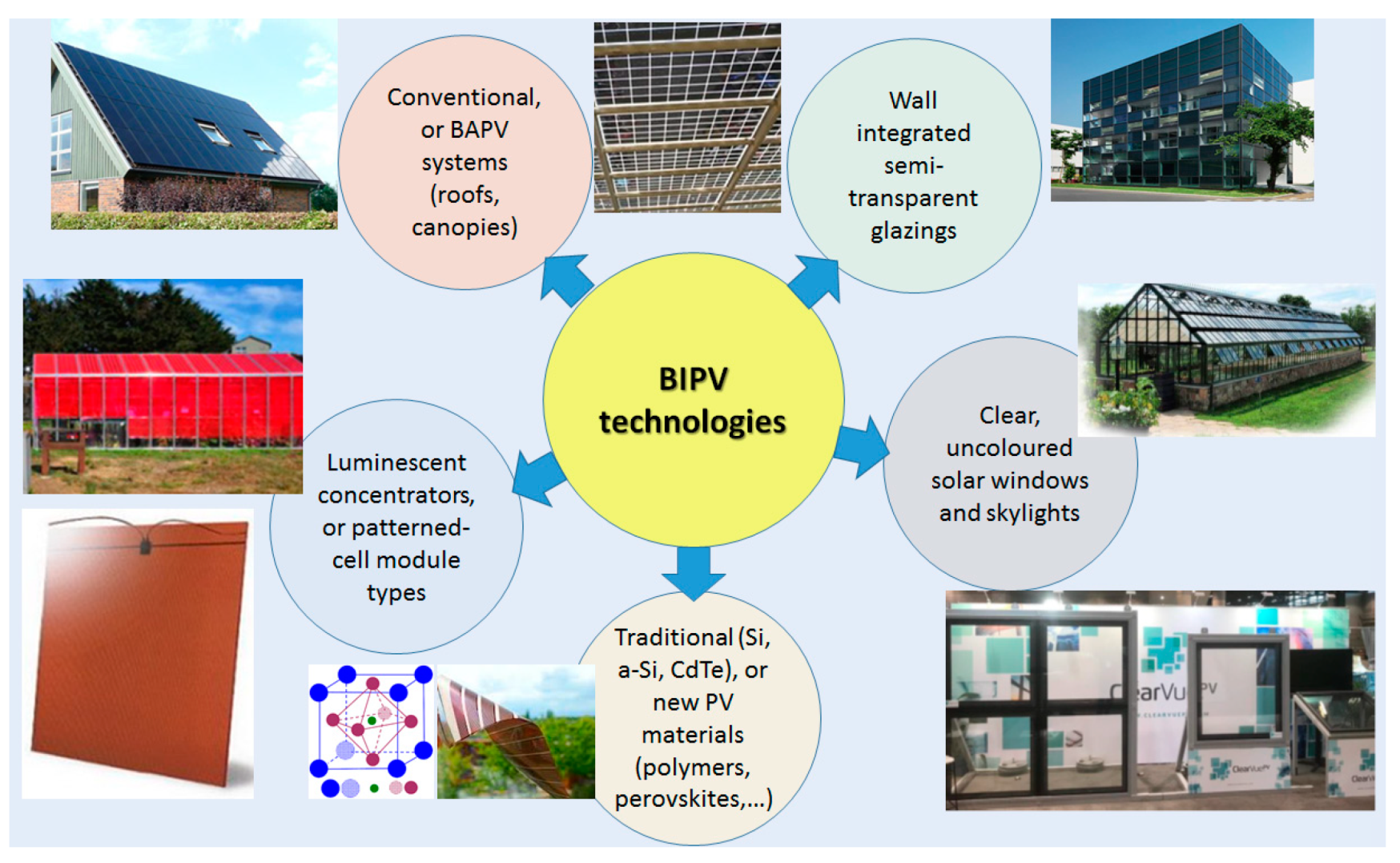
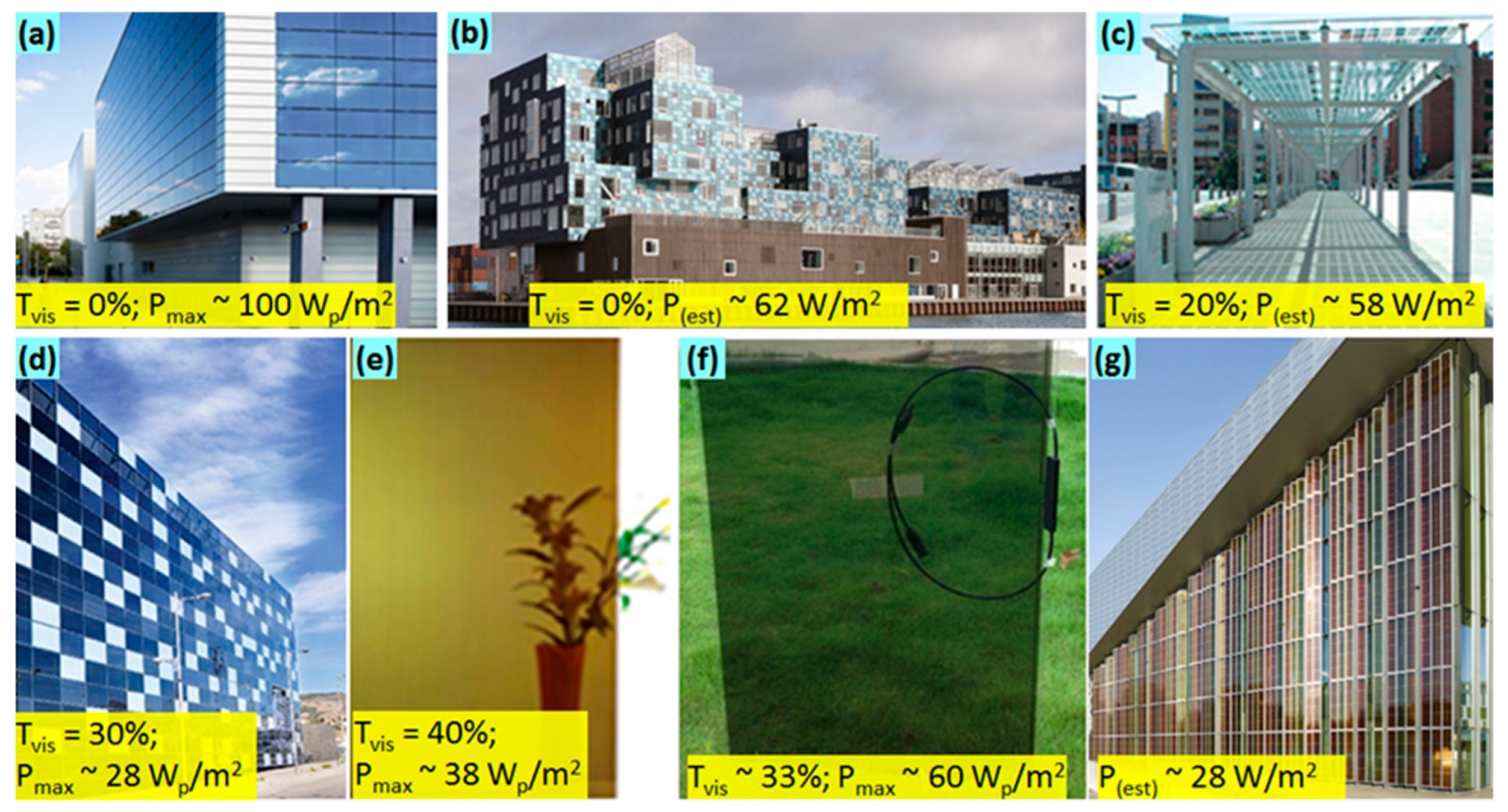
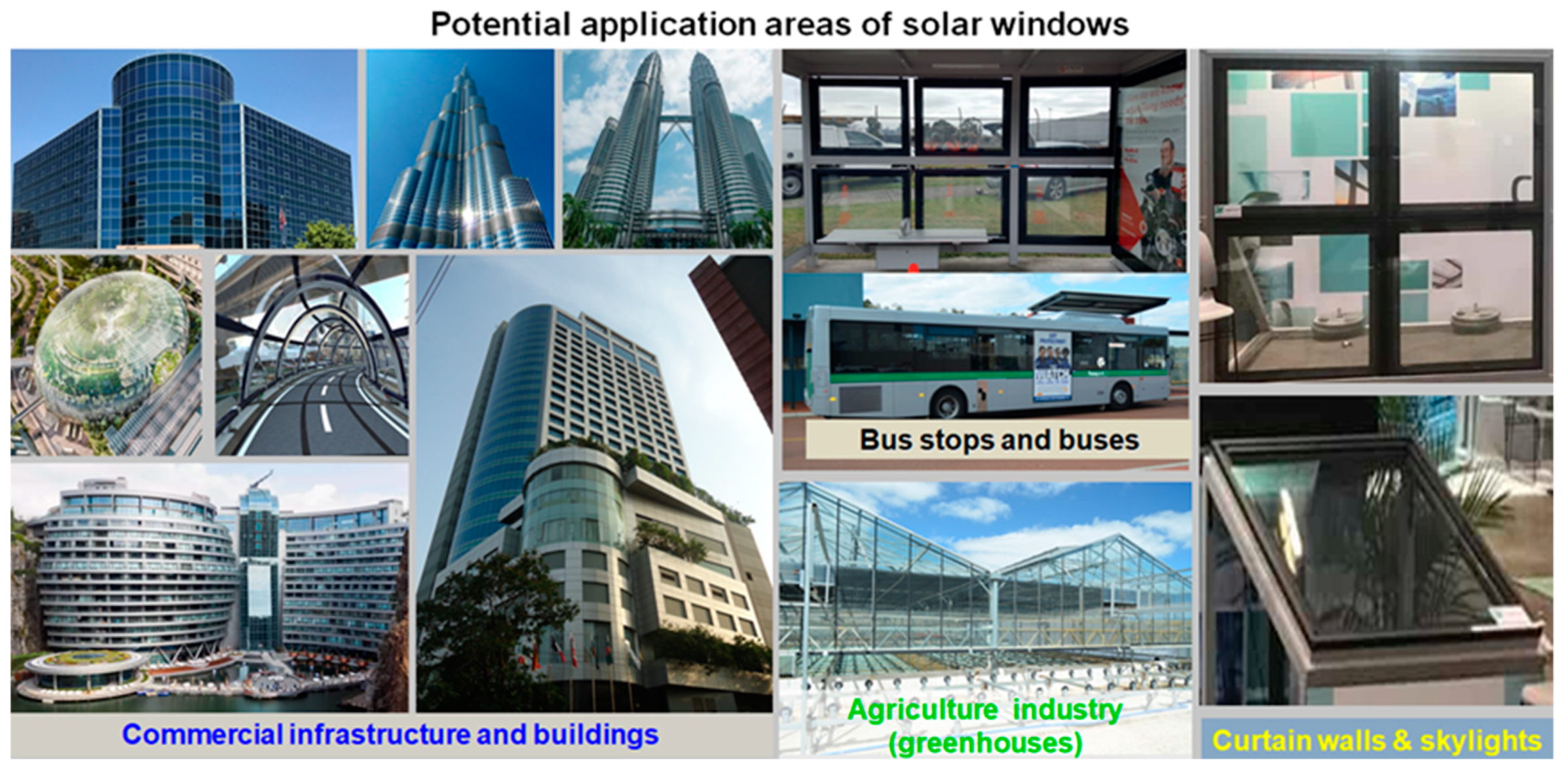
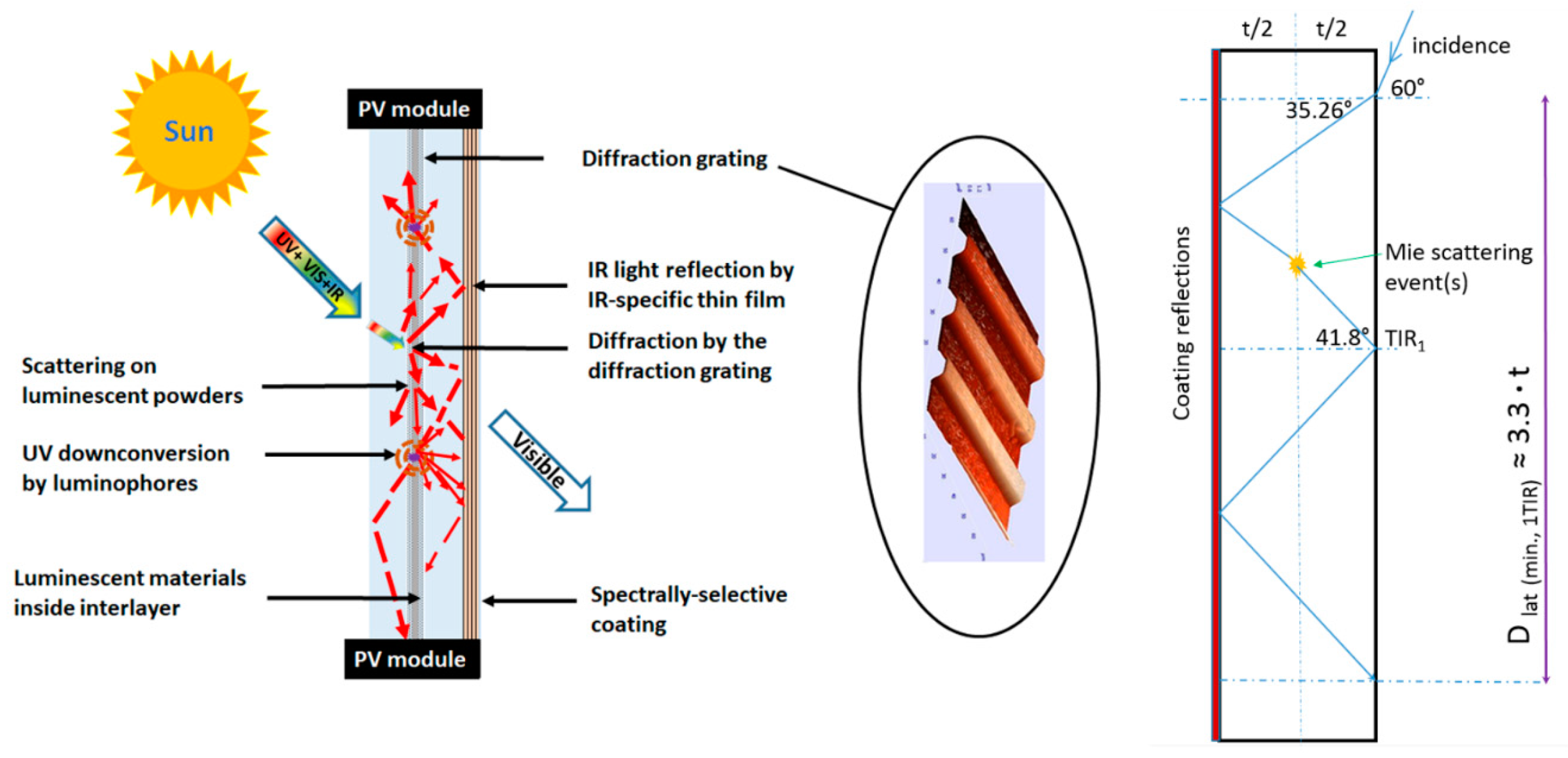
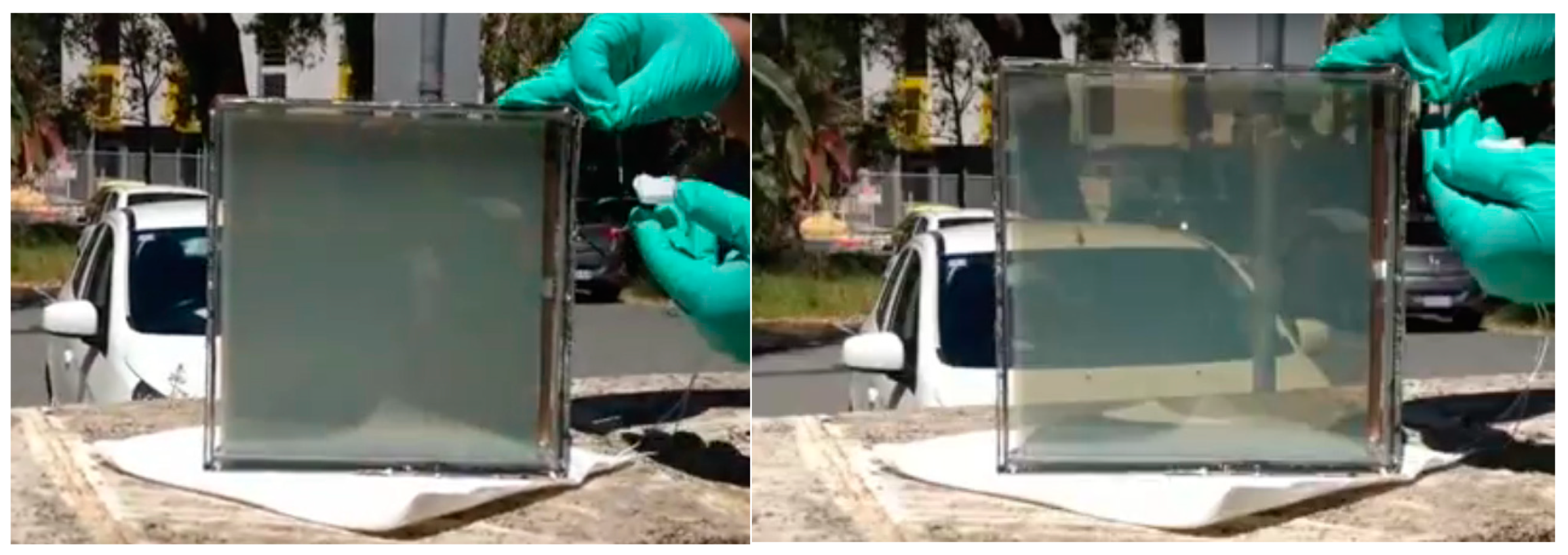

| Technology | Ref./Year | R&D Sample or Product | VLT | PCE or Pmax (est.) | Materials/Details |
|---|---|---|---|---|---|
| Dye-sensitised solar cells | [65]/2007 | sample | ~60%@ 550 nm | 9.2% | Screen-printed TiO2 films |
| Dye-sensitised solar cells (Solaronix) | [34,54]/2014 | product | N/A | ~28 W/m2, vert. | Evaluated from the available published data |
| Transparent PV solar cells | [66]/2011 | sample | >65% | (1.3±0.1) | Organic material-based, harvesting near-IR only |
| Transparent polymer SC | [61]/2012 | sample | 64% | 4.00% | Solution processing technology |
| Semi-transparent organic SC | [60]/2017 | sample | 32% | 9.77% | Organics (dithienocyclopentathieno[3,2-b]thiophene) |
| Perovskite SC | [67]/2015 | sample | ~77%@ 800 nm peak | 11.71% | Semi-transparent MAPbI3 cell with Ag-nanowire transparent electrode; for use in tandem cells. |
| Single-junction semitransparent perovskite SC | [68]/2014 | sample | 1) 29% 2) 22% | 1) 6.4% 2) 7.3% | Methylammonium lead iodide perovskite (CH3NH3PbI3) |
| Colloidal Quantum Dot SC | [69]/2016 | sample | 24.1% (ave.) | 5.4% | PbS colloidal QDs |
| BAPV glass-integrated PV roof (AGC Sunjoule) | [51]/2015 | product | ~20% of clear glass area | ~58 W/m2, horiz. | Mono-Si cells, separated laterally within glass |
| Hanergy BIPV panels | [53]/2018 | product | 40% (ave.) | 3.8% | Amorphous silicon |
| Onyx Solar BIPV panels | [52]/2018 | product | 30% (ave.) | 2.8% | Amorphous silicon |
| Solar First Energy Technology Co., Ltd. | [35]/2018 | product | ~33% | 6% | CdTe semitransparent BIPV modules |
| Polysolar BIPV | [70]/2018 | product | 50% (ave.) | ~55.5 Wp/m2 (5.55%) | CdTe PS-CT-40 BIPV modules (1200 × 600 × 7 mm) |
| Stability-enhanced perovskite SC | [71] /2018 | sample | N/A | Up to 20.2% | SnO2 electron transport layer replacing TiO2. T80 operational lifetime of 625 h. |
| Technology | Ref./Year | R&D Sample or Product | VLT | PCE or Pmax | Concentrator Performance Parameters | Materials/Details |
|---|---|---|---|---|---|---|
| 5 cm × 5 cm LSC, non-transparent (using >97% diffuse backside reflector) | [57]/2008 | sample | <3% | 7.1% | G = 2.5; P ≈ 0.246; Copt ≈ 0.616 | Lumogen F Red305 and Fluorescence Yellow CRS040; 4 GaAs cells at edges. Highest LSC efficiency to date. |
| Quantum-dot LSC, 10 cm × 10 cm | [42]/2018 | sample | 43.7% | 2.18% | P ≈ 0.198; ηopt = 8.1% | CuInS2/ZnS QDs and poly-Si cells (ηSi = 11%); PCE = 2.94%, if backside reflector is used. |
| Tandem Quantum-dot LSC, 15.2 cm × 15.2 cm | [83]/2018 | sample | ~30% | 3.1% | P ≈ 0.11; | CuInSe2/ZnS QDs; high-efficiency GaAs cells. |
| Quantum-dot LSC, 12 cm × 12 cm | [84]/2017 | sample | 70% | N/A | ηopt = 2.85% | Si QDs. |
| 50 cm × 50cm × 6cm LSC | [85]/2015 | sample | est. ~40% at peak | 1.26% | G = 20.83; P ≈ 0.057; Copt ≈ 1.187 | Sc-Si (22% eff.) cells at edges. Organic dyes (DTB, DPA). |
| 163 cm × 63 cm LSC panels for greenhouse applications | [80]/2016 | product | N/A (red coloured) | 3.4% | P ≈ 0.17; | Mono-Si cells (20%eff.) at back surface (13.9% area coverage, straight lines pattern). Lumogen Red 305. |
| 163 cm × 63 cm LSC panels for greenhouse applications | [80]/2016 | product | N/A (red coloured) | 3.8% | P ≈ 0.19; | Mono-Si cells (20%eff.) at back surface (13.9% area coverage, criss-crossed pattern). Lumogen Red 305. |
| “Leaf Roof”-type 110 cm × 0.5 cm LSC | [81]/2017 | sample | N/A (multi-coloured) | 5.8% | P ≈ 0.258; | Si cells (22.5% eff.) Multiple backside cells; Lumogen Red 305 mixed with other Lumogen pigments. |
| 100 cm × 75 cm clear glass windows of hybrid concentrator type | [55]/2018 | product | >65% (Tdirect) ≈ 70% (Ttotal) | ~25Wp/m2 ηconc. ≈ 1.425% ηtotal ≈ 2.5% | G = 4.25; P ≈ 0.116; Copt ≈ 0.492 | CuInSe2 cell modules (12.3% eff.); inorganic luminescent phosphor pigments; transparent near-IR reflector coating at back surface. |
| 20 cm × 20 cm semitransparent diffraction-assisted LSC | [77]/2018 | sample | >60% (Tdirect) | ≈2.347% | G = 2.8; P ≈ 0.176; Copt ≈ 0.495 | CuInSe2 cell modules (13.3% eff.) at edges; inorganic luminescent phosphor pigments; transparent near-IR reflector coating at back surface; embedded large-area transparent diffractive element. |
© 2019 by the authors. Licensee MDPI, Basel, Switzerland. This article is an open access article distributed under the terms and conditions of the Creative Commons Attribution (CC BY) license (http://creativecommons.org/licenses/by/4.0/).
Share and Cite
Vasiliev, M.; Nur-E-Alam, M.; Alameh, K. Recent Developments in Solar Energy-Harvesting Technologies for Building Integration and Distributed Energy Generation. Energies 2019, 12, 1080. https://doi.org/10.3390/en12061080
Vasiliev M, Nur-E-Alam M, Alameh K. Recent Developments in Solar Energy-Harvesting Technologies for Building Integration and Distributed Energy Generation. Energies. 2019; 12(6):1080. https://doi.org/10.3390/en12061080
Chicago/Turabian StyleVasiliev, Mikhail, Mohammad Nur-E-Alam, and Kamal Alameh. 2019. "Recent Developments in Solar Energy-Harvesting Technologies for Building Integration and Distributed Energy Generation" Energies 12, no. 6: 1080. https://doi.org/10.3390/en12061080
APA StyleVasiliev, M., Nur-E-Alam, M., & Alameh, K. (2019). Recent Developments in Solar Energy-Harvesting Technologies for Building Integration and Distributed Energy Generation. Energies, 12(6), 1080. https://doi.org/10.3390/en12061080







